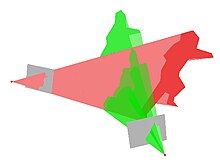

This article has multiple issues. Please help improve it or discuss these issues on the talk page. (Learn how and when to remove these template messages)
|


Avisual hull is a geometric entity created by shape-from-silhouette 3D reconstruction technique introduced by A. Laurentini. This technique assumes the foreground object in an image can be separated from the background. Under this assumption, the original image can be thresholded into a foreground/background binary image, which we call a silhouette image. The foreground mask, known as a silhouette, is the 2D projection of the corresponding 3D foreground object. Along with the camera viewing parameters, the silhouette defines a back-projected generalized cone that contains the actual object. This cone is called a silhouette cone. The upper right thumbnail shows two such cones produced from two silhouette images taken from different viewpoints. The intersection of the two cones is called a visual hull,[1] which is a bounding geometry of the actual 3D object (see the bottom right thumbnail). When the reconstructed geometry is only used for rendering from a different viewpoint, the implicit reconstruction together with rendering can be done using graphics hardware.[2]
This section needs expansion. You can help by adding to it. (December 2008)
|
A technique used in some modern touchscreen devices employs cameras placed in the corners situated opposite infrared LEDs. The one-dimensional projection (shadow) of objects on the surface may be used to reconstruct the convex hull of the object.[citation needed]
{{cite web}}: CS1 maint: multiple names: authors list (link)
|
Extended reality (XR)
| |||||||||||
|---|---|---|---|---|---|---|---|---|---|---|---|
| |||||||||||
| Concepts |
| ||||||||||
| Technologies |
| ||||||||||
| Peripherals |
| ||||||||||
| Devices |
| ||||||||||
| Software |
| ||||||||||